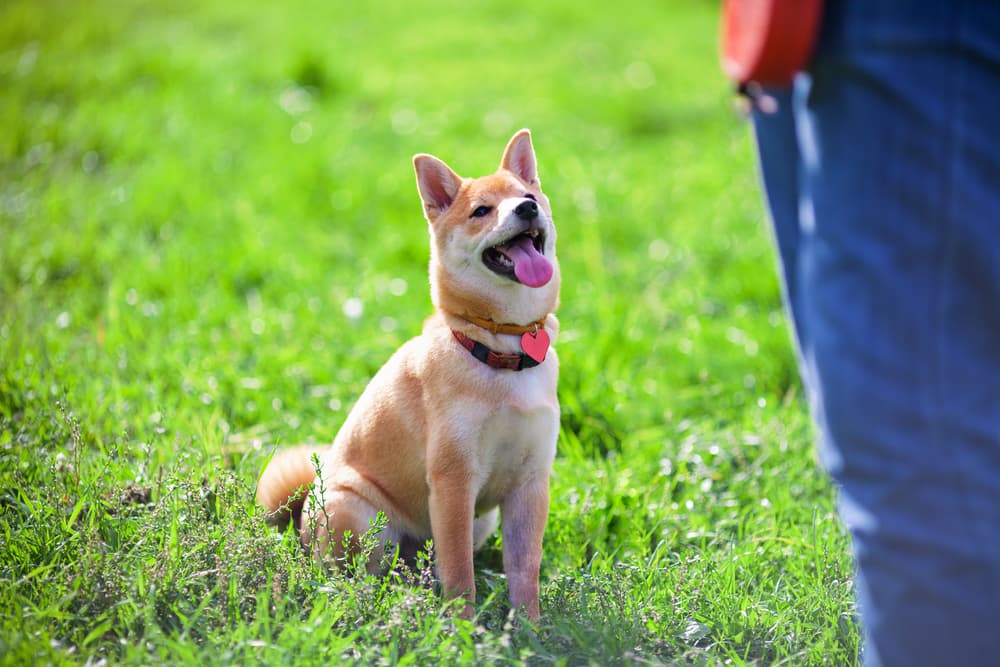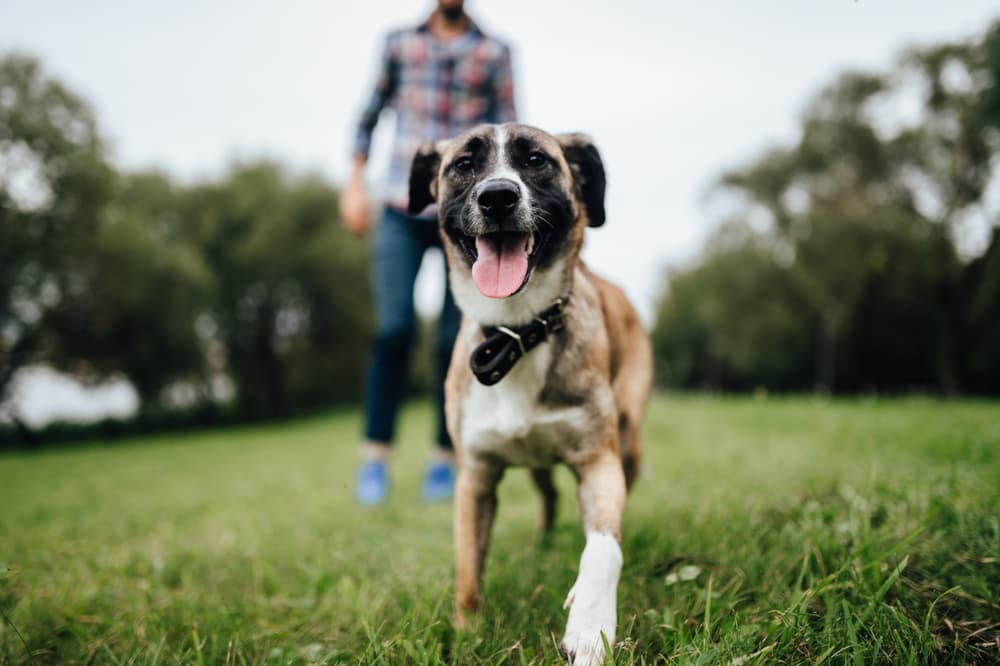By Victoria Schade
Reviewed by Stephanie Liff, DVM

There’s nothing quite like watching a pack of dogs frolicking together at the dog park. Spending time at the park helps keep a dog’s socialization skills in tip-top form and can wear out a busy pup in a way that walks around the block can’t touch.
Dog play at the park can look intense, but it shouldn’t be a lawless free-for-all. That’s why both pups and pet parents need to abide by very important dog park rules to keep their time safe at both ends of the leash.
Helping your dog master these must-know dog training commands will ensure dog-park playtime is fun and stress free.
Dog Park Etiquette and You
Before heading to the dog park, consider the following dog park rules of engagement to determine if park play is right for you and your pup.
Will your dog have fun?
It might come as a surprise to realize that not every dog enjoys spending time at the dog park. The best dog park pups are well socialized, welcome interactions with other dogs, and understand how to play appropriately.
For safety reasons, puppies under 6 months of age shouldn’t visit dog parks. There are vaccination concerns for younger pups, and because puppies are still developing their social skills, a single bad experience with an inappropriate dog at the dog park might derail their socialization progress. And keep in mind that senior dogs with aches and pains might have aged out of rough play.
Is the park suitable?
A safe dog park has divided spaces for big and little dogs, strong fencing, a double-door entry system, and enough land that it won’t get overcrowded. And when considering a park’s features don’t forget about the patrons. The best dog parks are frequented by responsible pet parents who are willing to pick up poop and stay in tune to their pup’s dog park behavior.
Do you understand canine body language?
Dog play can be rowdy and is easy to misinterpret, which is why the human end of the leash should have a solid foundation in reading dog body language. Understanding the difference between play fighting and the real thing will prevent misunderstandings or dog fights.
Is your dog protected against parasites?
When dogs spend time outside, socializing with other dogs or playing where other animals have been, they can be exposed to potentially harmful parasites. In a recent study of 288 parks across the U.S., more than 80 percent of parks had at least one dog test positive for intestinal parasites.[1]It’s important to keep your dog and others safe by ensuring he has adequate year-round protection from internal parasites like heartworm, hookworm, roundworm, whipworm, and tapeworm. A monthly chewable like Interceptor® Plus (milbemycin oxime/praziquantel) is a simple way to protect your dog against these five dangerous parasites no matter the season.
And don’t forget about the hazards of external parasites like ticks and fleas. A tasty chewable like Credelio® (lotilaner) can provide tick and flea protection.
See important safety information for Interceptor® Plus and Credelio® below.
Your pet should also be up to date on his vaccinations (e.g., Lyme disease, Bordetella) based on your region’s requirements and the recommendations of your veterinarian.
Dog Park Etiquette: Must-Know Cues
The true test of basic manners training is taking obedience skills on the road and using them in the real world. That said, the dog park is one of the most distracting training environments possible.
Before attempting training cues at the dog park, take the time to perfect them in and around your home so that your dog has a strong understanding of what’s being asked of him.
Keep in mind that dogs don’t always generalize their lessons to all locations, so a perfect sit in your yard might fall apart when introduced in the distraction-filled dog park.
But before you head to your neighborhood dog park, here are the top dog training commands you should work on with your pup.
Sit

The very first skill most new puppies learn is to sit, but getting dogs to perform this foundational behavior in exciting environments can be challenging.
The secret to success at the dog park is using it as access to real-life rewards, meaning that when your dog does respond to your “sit” cue his “treat” is getting to do what he wants. (Most dog parks don’t allow food treats inside so using real life rewards is a great alternative.)
When you arrive at the dog park gate, ask your dog to sit before opening it for him. Ask him to do it again as you take off his leash. Any time your dog runs over to check in with you, praise him, ask for a quick “sit” and then release him to go back and play.
This simple behavior can help your dog hone his focus while brushing up on his impulse control in an action-packed environment.
Wait

Wait is a casual teach-as-you-go cue that fits perfectly in a dog park scenario. Not as formal as “stay,” a “wait” cue encourages your dog to hold whatever position he happens to be in for a few moments.
You can begin teaching it in the car the moment you arrive at the park. Before your dog gets out of the car, take hold of his leash so that there’s no slack in it. Say “wait” then gently release the tension in the leash, pause for a moment and then release your dog out of the car with a cue like “free.”
The wait cue is helpful for quick lessons inside the park as well. If you arrive to an empty dog park, ask your dog to wait before you open the gate. Just don’t try it when there’s a crowd of dogs on the other side of the fence.
You can add it to a “sit” cue when your dog checks in with you by asking for the sit, saying “wait,” and then releasing him to go play.
Polite Leash Walking

While it’s not necessarily a distinct command, teaching your dog to politely walk on a leash is an essential behavior to learn before heading to the dog park.
Most dog park enthusiasts have a tough time controlling their excitement as they get close to the gate, which usually results in an uncontrolled sprint to the door. Allowing your dog to escalate to a fever pitch on the way into the park can ramp up your dog’s nervous energy level to the point where he’s out of control by the time he gets inside.
The problem is that many dogs have learned that pulling works—they pull, we follow. The easiest way to help your dog understand that pulling is no longer an option is making it have the opposite effect. Instead of bringing your dog closer to the park, it actually makes him lose ground.
The moment your dog begins pulling, meaning the leash is in a straight line, walk backward and away from the park. It’s important that you don’t just turn around as your dog might think you’re opting for a different route. The key to this exercise is showing your dog that pulling is taking him farther away from his goal.
The moment the leash goes slack begin walking toward the park again. You might have to back up several times in a row before your dog understands what’s going on, but don’t give up. In time, your dog will learn that a slack leash, not pulling, gets him where he wants to go.
Recall

The single most important cue for good dog-park behavior is a solid recall. Without it, you might end up chasing your dog when it’s time to leave, which is a game most dogs can’t resist. Plus, a strong recall can keep your dog safe if a scuffle breaks out.
Before you can even consider using your recall word (such as “come” or “here”) in the dog park, you have to make sure that it’s reliable and consistent in other locations, and that your dog thinks coming when you call is a super-fun game.
Rather than initially trying a recall in the dog park when your dog isn’t paying attention, use it when your dog is already heading in your direction. When you see your dog coming toward you kneel, say your recall word (which should be something other than your dog’s name), and praise your pup exuberantly as he gets closer. It’s a quick way to start cementing an important training cue in a chaotic environment.
Set your dog up for success by calling him to you when he’s not engaged in play with other dogs, then release him to go back and play with his friends. Calling him when he’s not distracted makes it easier for him to be successful, and releasing him immediately helps him understand that coming back to you doesn’t mean the end of the fun.
Finally, consider skipping your recall word when it’s time to leave the park. Rather than associating “come” or “here” with the signal that the fun is over, wait for a moment when your dog is close to you and leash him up.
Credelio (lotilaner) Indications
Credelio kills adult fleas and is indicated for the treatment and prevention of flea infestations, treatment and control of tick infestations (lone star tick, American dog tick, black-legged tick, and brown dog tick) for one month in dogs 8 weeks and older and 4.4 pounds or greater.
Credelio Important Safety Information
Lotilaner is a member of the isoxazoline class of drugs. This class has been associated with neurologic adverse reactions including tremors, incoordination, and seizures. Seizures have been reported in dogs receiving this class of drugs, even in dogs without a history of seizures. Use with caution in dogs with a history of seizures or neurologic disorders. The safe use of Credelio in breeding, pregnant or lactating dogs has not been evaluated. The most frequently reported adverse reactions are weight loss, elevated blood urea nitrogen, increased urination, and diarrhea. For complete safety information, please see Credelio product label or ask your veterinarian.
Interceptor Plus (milbemycin oxime/praziquantel) Indications
Interceptor Plus prevents heartworm disease and treats and controls adult roundworm, hookworm, whipworm, and tapeworm infections in dogs and puppies 6 weeks or older and 2 pounds or greater.
Interceptor Plus Important Safety Information
Treatment with fewer than 6 monthly doses after the last exposure to mosquitoes may not provide complete heartworm prevention. Prior to administration of Interceptor Plus, dogs should be tested for existing heartworm infections. The safety of Interceptor Plus has not been evaluated in dogs used for breeding or in lactating females. The following adverse reactions have been reported in dogs after administration of milbemycin oxime or praziquantel: vomiting, diarrhea, decreased activity, incoordination, weight loss, convulsions, weakness, and salivation. For complete safety information, please see Interceptor Plus product label or ask your veterinarian.
Disclaimer: The author received compensation from Elanco US Inc., the maker of Interceptor Plus and Credelio, for her services in writing this article.
Credelio and Interceptor are trademarks of Elanco or its affiliates.
© 2020 Elanco. PM-US-19-2077
 Toledo, United States.
Toledo, United States.